Related Research Articles

The S60 Platform is a discontinued software platform for smartphones that runs on top of the Symbian operating system. It was created by Nokia based on the 'Pearl' user interface from Symbian Ltd. It was introduced at COMDEX in November 2001 and first shipped with the Nokia 7650 smartphone. The platform has since seen 5 updated editions. Series 60 was renamed to S60 in November 2005.

The Nokia N95 is a mobile phone produced by Nokia as part of their Nseries line of portable devices. Announced in September 2006, it was released to the market in March 2007. The N95 ran S60 3rd Edition, on Symbian OS v9.2. It has a two-way sliding mechanism, which can be used to access either media playback buttons or a numeric keypad. It was first released in silver and later on in black, with limited edition quantities in gold and purple. The launch price of the N95 was around €550.
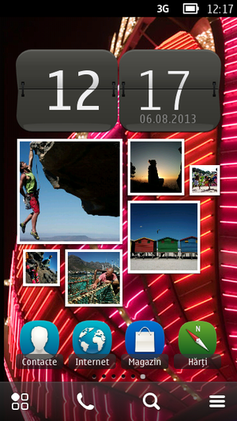
Symbian is a discontinued mobile operating system (OS) and computing platform designed for smartphones. It was originally developed as a proprietary software OS for personal digital assistants in 1998 by the Symbian Ltd. consortium. Symbian OS is a descendant of Psion's EPOC, and was released exclusively on ARM processors, although an unreleased x86 port existed. Symbian was used by many major mobile phone brands, like Samsung, Motorola, Sony Ericsson, and above all by Nokia. It was also prevalent in Japan by brands including Fujitsu, Sharp and Mitsubishi. As a pioneer that established the smartphone industry, it was the most popular smartphone OS on a worldwide average until the end of 2010, at a time when smartphones were in limited use, when it was overtaken by iOS and Android. It was notably less popular in North America.

The Nokia N8 is a touchscreen-based smartphone developed by Nokia. Announced on 27 April 2010, the Nokia N8 was the first device to run on the Symbian^3 mobile operating system and it was the company's flagship device for the year. It was released on 30 September 2010 at the Nokia Online Store before being released in markets around the world on 1 October 2010. There were two versions made, the N8 and the N8-00. The N8 was made for Vodafone and locked to its networks, and the N8-00 was made by Microsoft and open network.

The Nokia C7-00 is a smartphone from the Nokia Cseries. It was introduced on 14 September 2010 and released in Q4 2010. The C7-00 features a 3.5-inch (89 mm), 640 x 360 pixel capacitive touchscreen and features 720p video recording, and was also the world's first smartphone to have NFC capability. Nokia's mobile phone business head Anssi Vanjoki called it the "sleekest" device in the world. Unlike the Nokia N8 flagship, the C7 has physical call and hangup buttons.
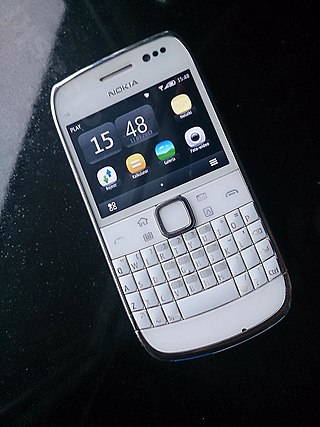
The Nokia E6-00 is a mobile phone running the Symbian^3 operating system. It supersedes the Nokia E72 as the new Symbian business mobility solution from Nokia following its announcement on 12 April 2011. It shipped with the new "Symbian Anna" version of Symbian^3, and originally retailed for 340 euros before taxes.

The Nokia N9 is a flagship smartphone developed by Nokia, running on the Linux-based MeeGo mobile operating system. Announced in June 2011 and released in September, it was the first and only device from Nokia with MeeGo, partly because of the company's partnership with Microsoft announced that year. It was initially released in three colors: black, cyan and magenta, before a white version was announced at Nokia World 2011.
Nokia's strategic nomenclature can be traced back in 2005 when the Nseries line was launched, offering devices with flagship specifications and premium hardware at various price points. These devices were considered the "bread and butter" of the company and were often positioned to showcase their latest technologies. Thanks to the newfound consumer and enterprise interest in smartphones at the time, the company introduced four additional collections to diversify their product portfolio and meet demands in most market segments. These new phone series were named Eseries, targeting small business and enterprise customers; Xseries, providing consumer-grade multimedia-focused devices; Cseries, which Nokia used to target both the low-end and mid-range market segments; and Tseries, for devices exclusive to the Chinese market.
The Nokia 701 is an entry level Symbian Belle smartphone by Nokia. It was announced on 24 August 2011 and released in the third quarter of 2011. It shipped with the "Belle" version of Symbian^3. It has a 3.5" IPS LCD display with 640 x 360 pixels. The brightness of the display is 1000 nits and uses Corning Gorilla Glass. Its design is very much based on that of the Nokia C7. A Nokia Belle update increased the processor speed of the Nokia 701 from 1.0 GHz to 1.3 GHz.
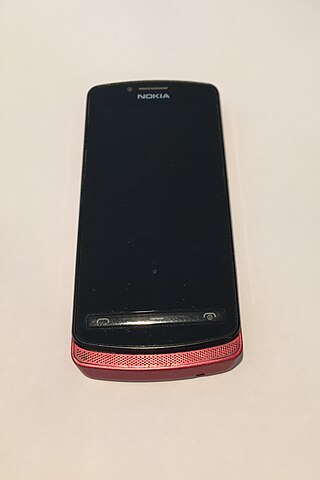
The Nokia 700 is an ultra slim Symbian Belle smartphone by Nokia, running Nokia Belle operating system. It was announced on 24 August 2011 and released in September 2011. Nokia claimed it was its most eco-friendly smartphone.
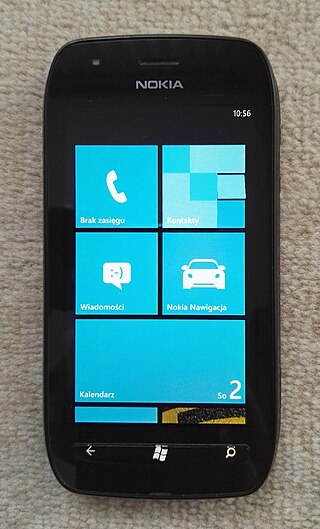
Nokia Lumia 710 is a Windows Phone 7 smartphone. Its release is part of a change in company's direction which has resulted in a shift from Symbian platform towards Windows Phone for smartphones. While the Nokia Lumia 800 and Lumia 900 target the high-end of the smartphone marketplace, the Lumia 610 and Lumia 710 are aimed at the mid-range price point. This generation of Lumia phones ship with Windows Phone 7.5 "Mango". Its design is almost the same as the Symbian Nokia 603, announced just over a week earlier.

Nokia Lumia 610 is a Windows Phone smartphone announced at Mobile World Congress 2012. It is designed for young consumers that are buying their first smartphone. The Lumia 610 has a curvy, metallic design. Like the Lumia 710, it comes in cyan, magenta, black and white. The black and magenta version have a rubberized back instead of the glossy back as found in the white and cyan version of this phone.

Microsoft Lumia is a discontinued line of mobile devices that was originally designed and marketed by Nokia and later by Microsoft Mobile. Introduced in November 2011, the line was the result of a long-term partnership between Nokia and Microsoft—as such, Lumia smartphones run on Microsoft software, the Windows Phone operating system; and later the newer Windows 10 Mobile. The Lumia name is derived from the partitive plural form of the Finnish word lumi, meaning "snow".

The Nokia 603 is an entry level Symbian Belle smartphone by Nokia. It was announced on 13 October 2011. It ships with the Symbian Belle OS. Later with the release of Nokia 808 PureView, an update of Belle Feature Pack 2 was released for the phone. Nokia 603 is a low-cost device featuring a 3.5-inch ClearBlack display, 1.0 GHz processor, and NFC.

The Nokia Lumia 620 is an entry-level smartphone designed, developed and marketed by Nokia. It is the successor to the Lumia 610, and is one of the first Nokia phones to implement Windows Phone 8 alongside the Nokia Lumia 920 and Nokia Lumia 820. Although sharing a similar name with the Lumia 610, the Lumia 620 is a major overhaul over its predecessor, employing a 1.0 GHz dual-core processor. It also has exchangeable back covers which come in black, white, magenta, yellow, cyan etc.

The Nokia Lumia 1520 was a flagship Windows Phone phablet smartphone designed and produced by Finnish telecommunications manufacturer Nokia in partnership with American software manufacturer Microsoft. The device was first announced at the Nokia World event on 22 October 2013 in Abu Dhabi, alongside its mid-range phablet stablemate the Nokia Lumia 1320 and Nokia's 10.1 inch Windows RT tablet the Nokia Lumia 2520. Until its discontinuation in the United States on 7 April 2015 the phone served as the flagship device for Nokia's Lumia Series and Microsoft's mobile effort. On 6 October 2015 Microsoft officially announced its flagship phablet successor, the Microsoft Lumia 950 XL, with availability sometime in November 2015.
The Nokia 3-digit series are a series of feature and smartphones by HMD Global and previously by Microsoft Mobile and Nokia, generally aimed at developing markets.

Human Mobile Devices (HMD), formally HMD Global, is a Finnish mobile phone manufacturer. The company is made up of the mobile phone business that the Nokia Corporation sold to Microsoft in 2014, then bought back in 2016. HMD began marketing Nokia-branded smartphones and feature phones on 1 December 2016. The company has exclusive rights to the Nokia brand for mobile phones through a licensing agreement. The HMD brand was initially only used for corporate purposes and does not appear in advertising, whereas the name "Nokia Mobile" is used on social media. As it was launched, the abbreviation HMD stood for Hon Hai Mobile Devices. This was in reference to the main shareholder at the time of its creation: the Taiwanese group Foxconn. In January 2024, HMD rebranded to 'Human Mobile Devices', and will use their own branding on future devices alongside that of Nokia.
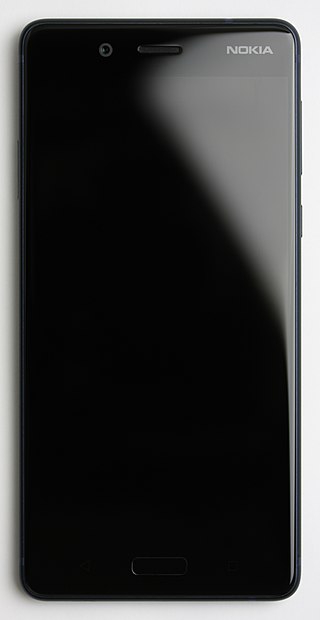
The Nokia 8 is a flagship Nokia-branded smartphone running the Android operating system. Announced on 16 August 2017 in London, England by HMD Global. The phone began sales in Europe in September 2017. Nokia 8 is the first high-end Nokia-branded device since the Nokia Lumia 930 in 2014. An improved version, the Nokia 8 Sirocco, was announced on 25 February 2018 at the Mobile World Congress in Barcelona.

The Nokia 7 Plus is a Nokia-branded upper-mid-range smartphone running the Android operating system. It was announced on 25 February 2018, along with four other Nokia-branded phones.
References
- 1 2 3 Molen, Brad (24 August 2011). "Nokia announces Symbian Belle alongside three new devices". Engadget . Retrieved 2024-05-22.
- ↑ Molen, Brad (3 November 2011). "Goodbye Nokia 600, we hardly knew ye". Engadget . Retrieved 2024-05-22.
- ↑ "Nokia 600 - Full phone specifications". GSMArena.com. Retrieved 2023-02-23.
- ↑ Blandford, Rafe (24 August 2011). "Nokia 600 - loud sound and NFC for the mid tier". All About Symbian. Retrieved 2024-05-22.